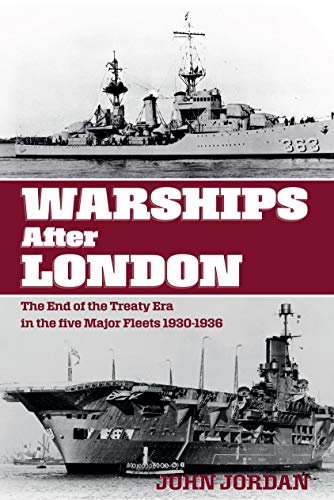
Warships after London. By John Jordan. Seaforth Publishing, 2020. ISBN 978-1-5267-7749-2
Reviewed by David Hobbs
The sequel to John Jordan’s earlier Warships after Washington published in 2011 and reprinted as a paperback in 2015, this book completes the author’s description of the era of treaty limitations prior to 1936 within which the politicians of the five major naval powers, Great Britain, the USA, Japan, France and Italy, sought to place limits on warship construction.
It brings together both naval and political perspectives and Jordan begins by describing how the Washington Treaty signed in 1922 had failed to place quantitive limits on surface units outside the closely-defined capital ship and aircraft carrier categories. The result had been something of an arms race as the five navies, freed from the expense of battleship construction, built ‘treaty cruisers’ such as the RAN’s Australia and Canberra up to the qualitative limits allowed but with no limit on numbers other than those imposed by national budgets. The Treaty that emerged from the London Conference in 1930 was intended to bring order to this perceived chaos with tight definitions of warships in the cruiser, destroyer, submarine and auxiliary categories and quantitative limits on the tonnage of each that the signatory navies could retain before 1936 when the Washington Treaty was due to expire.
The London Treaty had a critical impact on many warship projects since navies had to trade unit size and capability against the total tonnage allowed for the various categories and this inevitably led to smaller, densely-packed designs in which naval staffs sought to retain the heavy surface armaments with which previous classes had been equipped. Once the period of treaty limitation ended in December 1936 and international tensions moved inexorably towards another world war these limited displacement designs proved problematical as new technologies such as radar, HF/DF, improved weapon control systems, greatly enhanced anti-aircraft and anti-submarine armaments and remote power control for gun mountings had to be ‘shoe-horned’ into new designs that were already close to their stability limitations. Some were complete failures with at least one Japanese escort vessel capsizing, others were more successful. During the period described in this book the RAN operated ships and equipment of British design and was considered for treaty purposes to be part of a single imperial British fleet. Many of the RN ships described in these pages are, therefore relevant to the RAN and descriptions of the cruiser designs that led to Sydney, Perth and Hobart are particularly so, as are the Tribal and ‘N’ class destroyers and the seaplane carrier Albatross. The designs of the Italian and Japanese vessels they fought against are also of interest.
The book is well illustrated with carefully-chosen photographs and about fifty of the author’s own excellent ship drawings to show important design features. The wording of the Treaty for the Limitation and Reduction of Naval Armament – London – 22 April 1930 to give its full title is included in an appendix so that readers can study it in full. Both it and its implications are discussed in the opening chapter in which the author demonstrates both his depth of knowledge and insight into the subject matter. Subsequent chapters cover capital ships, aircraft carriers, cruisers, destroyers, submarines, small combatants and auxiliaries and are sub-divided into sections on the British, US, Japanese, French and Italian navies with conclusions to sum up each chapter. The timing of the London Treaty meant that the ships that emerged under its limitations were those coming into service on the outbreak of war; their design evolution, strengths and weaknesses are, therefore, of considerable interest. I would particularly like to draw potential readers’ attention to the clarity with which Jordan describes the naval staff aspirations of the five powers and the different ways in which they envisaged using their fleets, not all of which transpired in the way they had expected. The unique position in which the Royal Navies of the Commonwealth found themselves, potentially having to operate across the globe against three hostile powers, Japan, Italy and a resurgent Germany, from the late 1930s is a recurring theme. As one would expect the main text is supported by pages devoted to acronyms and abbreviations, bibliography and an index. I found the set of conversion tables on page 10 particularly useful when comparing design details of warships that are shown in either Imperial measurement (Great Britain and the USA) or metric (France, Italy and Japan).
Warships after London justifies the publisher’s statement on the dust jacket that it is ‘a major contribution to understanding the nature of the navies involved’ when war broke out in 1939. Not only do I fully recommend it as a significant addition to the historiography of warship design, I would also urge anyone who has not read its prequel Warships after Washingtonto get hold of a copy of that as well to give complete understanding of the treaty era and the way the major navies developed during the inter-war period. It is referred to often in the text of the new book. Whether you have read the earlier book or not, however, John Jordan’s new book gives outstanding insight into the design of warships in an unusually complicated era and explains many of the underlying reasons for their performance in the Second World War. I strongly recommend it.



